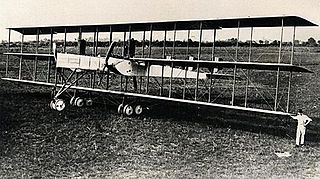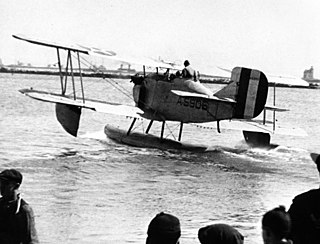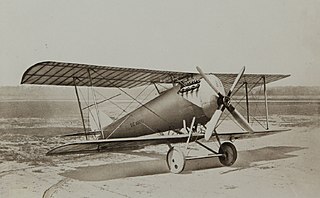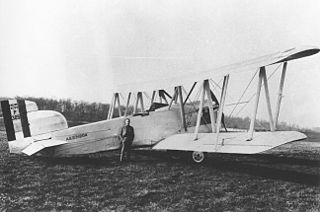Operators
 United States
United States
| BVL-12 | |
|---|---|
| Role | Experimental biplane bomber |
| Manufacturer | Engineering Division/Pomilio Brothers |
| Designer | Ottorino Pomilio |
| First flight | 1919 |
| Primary user | United States Army Air Corps |
| Number built | 6 |
The Pomilio BVL-12 was an American experimental single-engine biplane bomber built by the United States Army Engineering Division to the design of Ottorino Pomilio for the United States Army Air Corps after World War I.
Powered by a 400 hp (298 kW) Liberty V12, it would seat two. It featured an equal-span wing, the lower of the pair attached to the fuselage by struts, unique in the United States, rather than directly, which was more usual. Performance proved disappointing, and only six trial models were built.
General characteristics
Performance
Related lists

The Curtiss Falcon was a family of military biplane aircraft built by the American aircraft manufacturer Curtiss Aeroplane and Motor Company during the 1920s. Most saw service as part of the United States Army Air Corps as observation aircraft with the designations O-1 and O-11, or as the attack aircraft designated the A-3 Falcon.

The Caproni Ca.4 was an Italian heavy bomber of the World War I era.

The Bristol F.2 Fighter is a British First World War two-seat biplane fighter and reconnaissance aircraft developed by Frank Barnwell at the Bristol Aeroplane Company. It is often simply called the Bristol Fighter, "Brisfit" or "Biff".

The Douglas DT bomber was the Douglas Aircraft Company's first military contract, forging a link between the company and the United States Navy. Navy Contract No. 53305 of April 1, 1921, required only 18 pages to set out the specifications that resulted in the purchase of three DT folding-wing aircraft.

The Airco DH.4 is a British two-seat biplane day bomber of the First World War. It was designed by Geoffrey de Havilland for Airco, and was the first British two-seat light day-bomber capable of defending itself.

The Fokker F.VII, also known as the Fokker Trimotor, was an airliner produced in the 1920s by the Dutch aircraft manufacturer Fokker, Fokker's American subsidiary Atlantic Aircraft Corporation, and other companies under licence.

The Douglas C-1 was a cargo/transport aircraft produced by the Douglas Aircraft Corporation for the United States Army Air Service starting in 1925.

The Vought O2U Corsair was a 1920s biplane scout and observation aircraft. Developed by Vought Corporation, the O2U was ordered by the United States Navy (USN) in 1927. Powered by a 400 hp (298 kW) Pratt & Whitney R-1340 engine, it incorporated a steel-tube fuselage structure and a wood wing structure with fabric covering. Many were seaplanes or amphibians.

The Elias EM was a 1920s American general-purpose and marine expeditionary biplane built by Elias.

The Curtiss Eagle was an airliner produced in small numbers in the United States shortly after World War I. The aircraft was a conventional biplane with three-bay, unstaggered wings of equal span. The fuselage was a very advanced design for its day, incorporating careful streamlining of its monocoque structure, and offering the crew as well as the passengers a fully enclosed cabin. The Eagle is sometimes named as the first American tri-motor aircraft; however Curtiss' own Model H flying boat flew with three engines for a time in 1914 before being converted back to twin-engine configuration.

The Loening OL, also known as the Loening Amphibian, was an American two-seat amphibious biplane designed by Grover Loening and built by Loening for the United States Army Air Corps and the United States Navy.

The Martin MB-1 was an American large biplane bomber designed and built by the Glenn L. Martin Company for the United States Army Air Service in 1918. It was the first purpose-built bomber produced by the United States.

The LUSAC-11 was an early American two-seat fighter aircraft. It was a French design, commissioned and built in the United States during World War I and ordered in large numbers by the United States Army Air Corps, but these were cancelled at the end of the war, and only 30 were built. The type was used for experimental purposes, setting several altitude records during the 1920s.

The Pomilio FVL-8 was a biplane fighter aircraft built by Fabbrica Aeroplani Ing. O. Pomilio for Engineering Division of the Aviation Section, U.S. Signal Corps.

The Engineering Division TP-1 was a two-seat biplane fighter designed by Alfred V. Verville and Virginius E. Clark at the United States Army Air Corps Engineering Division. A second aircraft was completed as an observation biplane and designated the Engineering Division XCO-5.

The Engineering Division XCO-6 was an American two-seat observation biplane designed by the United States Army Engineering Division, only two were built and the type did not enter production.
The Orenco IL-1 was an American two-seat liaison biplane built for the United States Army by the Ordnance Engineering Corporation (Orenco). The Model E-2 was a conventional biplane powered by a 400 hp (298 kW) Liberty 12 engine and designated IL-1 by the Army. First flown in 1919, two aircraft were built and evaluated by the Army at McCook Field as P-147 and P-168, but the type did not enter production.
The L-W-F T-3 was an American eight-passenger transport biplane built for the United States Army Air Service (USAAS) by the L-W-F Engineering Company Inc. Designated T-3 by the Army it was a conventional biplane powered by a 400 hp (298 kW) Liberty L-12A engine. It had an open cockpit for the pilot and an enclosed cabin for eight passengers. The sole T-3 was delivered to the USAAS in 1923, re-designated XT-3 and used as an engine test bed. A further nine T-3s on order were cancelled and not built.
The Engineering Division XCO-2 was an observation aircraft designed at the United States Army Air Corps Engineering Division.

G Elias & Brother was and American manufacturer of cabinets and aircraft based in Buffalo, New York in the 1920s. A.G. Elias sat on the Manufacturers Aircraft Association's board of directors along with President Frank H. Russell, VP Glenn L. Martin, Charles L. Laurence, Chance M. Vought, S.S. Bradley, George P. Tidmarsh, and Donald Douglas. E.J Elias promoted the construction of a Buffalo municipal airport to aid the local fledgling airplane industry of five aviation companies constructing airplanes and airplane parts. From 1920 to 1925, Elias company's chief engineer, David Earle Dunlap (1896-1957), designed the Elias EM-2 Expeditionary planes. He designed the NBS-3 bomber fuselage and the Elias M-1 Mail plane. Dunlap's Elias TA-1 design was the first United States Army Air Corps Trainer to have a radial engine. After tests a McCook Field, the Army Air Corps selected other manufacturers over the Elias bomber and trainer. The company designed the Elias EM-1 to meet requirements for a multirole amphibian marine expeditionary aircraft. Elias delivered six production Elias EM-2 aircraft with Liberty engines to the United States Navy in 1922.